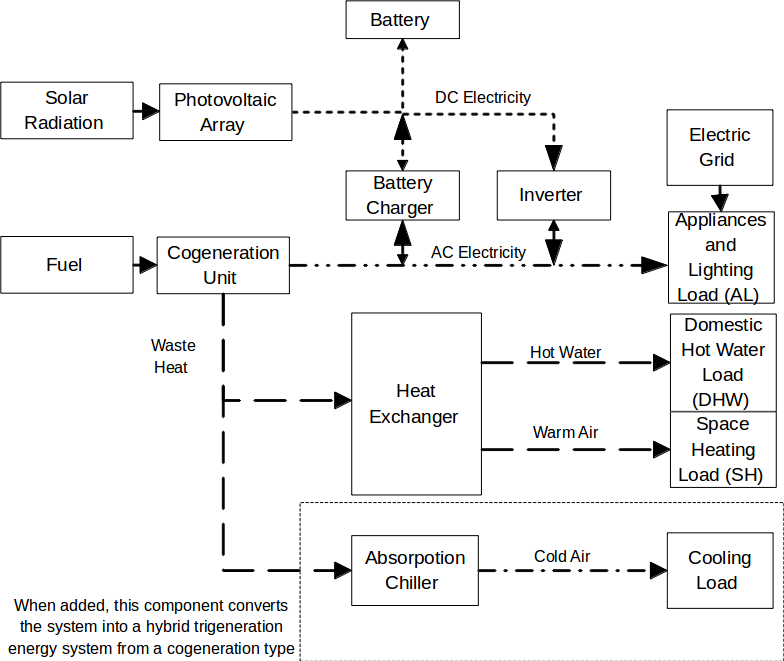J.M.Pearce (talk | contribs) m (→See Also) |
J.M.Pearce (talk | contribs) m (→Abstract) |
||
| Line 11: | Line 11: | ||
==Abstract== | ==Abstract== | ||
Recent work has proposed that hybridization of residential-scale [[cogeneration]] with roof-mounted solar PV ([[photovoltaic]]) arrays can increase the PV penetration level in ideal situations by a factor of five. In regions where there is a significant cooling load PV-cogen hybrid systems could be coupled to an absorption chiller to utilize waste heat from the cogen unit. In order to investigate realistic (non-ideal) loads that such a hybrid system would need to service, a new numerical simulation called PVTOM (PV-trigeneration optimization model) was created and coupled to the results of the established CHREM ([[Canadian Hybrid Residential End-Use Energy and Emissions Model]]). In this paper, [[PVTOM]] is applied to representative houses in select Canadian regions, which experience cooling loads, to assess the fuel utilization efficiency and reduction in greenhouse gas emissions from hybrid PV-cogen and [[trigen]] systems in comparison with conventional systems. Results of the optimization runs are provided and the efficacy of PV-cogen and PV-trigen systems is discussed. Both PV-trigen and PV-cogen systems have demonstrated to be more effective at reducing emissions when compared to the current combination of centralized power plants and household heating technologies in some regions. | Recent work has proposed that hybridization of residential-scale [[cogeneration]] with roof-mounted solar PV ([[photovoltaic]]) arrays can increase the PV penetration level in ideal situations by a factor of five. In regions where there is a significant cooling load PV-cogen hybrid systems could be coupled to an absorption chiller to utilize waste heat from the cogen unit. In order to investigate realistic (non-ideal) loads that such a hybrid system would need to service, a new numerical simulation called PVTOM (PV-trigeneration optimization model) was created and coupled to the results of the established CHREM ([[Canadian Hybrid Residential End-Use Energy and Emissions Model]]). In this paper, [[PVTOM]] is applied to representative houses in select Canadian regions, which experience cooling loads, to assess the fuel utilization efficiency and reduction in greenhouse gas emissions from hybrid PV-cogen and [[trigen]] systems in comparison with conventional systems. Results of the optimization runs are provided and the efficacy of PV-cogen and PV-trigen systems is discussed. Both PV-trigen and PV-cogen systems have demonstrated to be more effective at reducing emissions when compared to the current combination of centralized power plants and household heating technologies in some regions. | ||
[[image:Trigen-pv.png|Hybrid photovoltaic trigen system]] | |||
==See Also== | ==See Also== | ||
* [[PV_and_CHP_hybrid_systems]] | * [[PV_and_CHP_hybrid_systems]] | ||
* [[PV_and_CHP_Literature_review]] | * [[PV_and_CHP_Literature_review]] | ||
Revision as of 01:16, 11 December 2012
Source
- A.H. Nosrat, L.G. Swan, J.M. Pearce, "Improved Performance of Hybrid Photovoltaic-Trigeneration Systems Over Photovoltaic-Cogen Systems Including Effects of Battery Storage", Energy (in press). DOI(open access coming soon)
Abstract
Recent work has proposed that hybridization of residential-scale cogeneration with roof-mounted solar PV (photovoltaic) arrays can increase the PV penetration level in ideal situations by a factor of five. In regions where there is a significant cooling load PV-cogen hybrid systems could be coupled to an absorption chiller to utilize waste heat from the cogen unit. In order to investigate realistic (non-ideal) loads that such a hybrid system would need to service, a new numerical simulation called PVTOM (PV-trigeneration optimization model) was created and coupled to the results of the established CHREM (Canadian Hybrid Residential End-Use Energy and Emissions Model). In this paper, PVTOM is applied to representative houses in select Canadian regions, which experience cooling loads, to assess the fuel utilization efficiency and reduction in greenhouse gas emissions from hybrid PV-cogen and trigen systems in comparison with conventional systems. Results of the optimization runs are provided and the efficacy of PV-cogen and PV-trigen systems is discussed. Both PV-trigen and PV-cogen systems have demonstrated to be more effective at reducing emissions when compared to the current combination of centralized power plants and household heating technologies in some regions.


